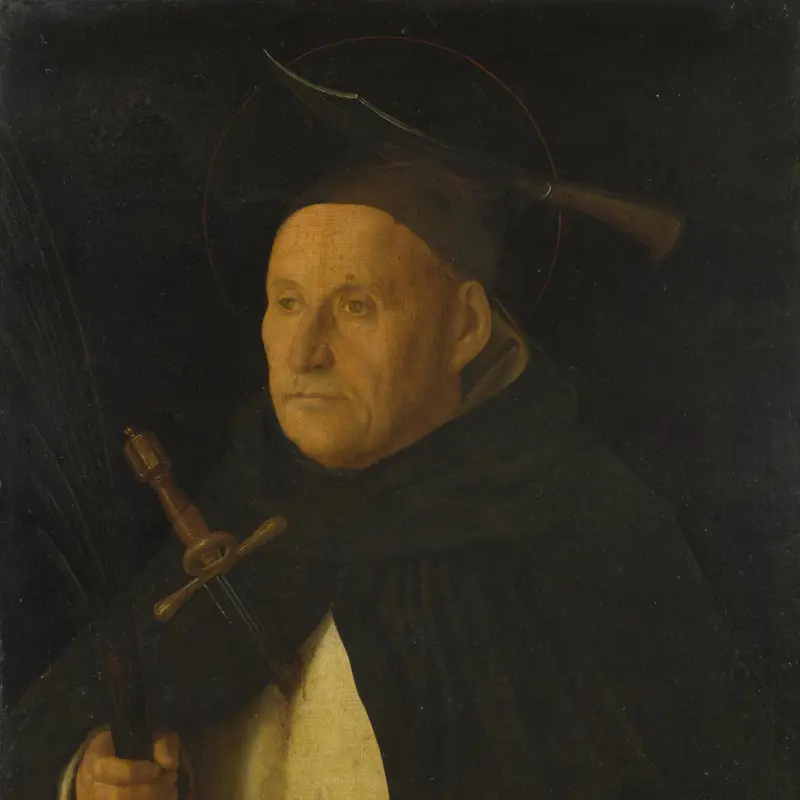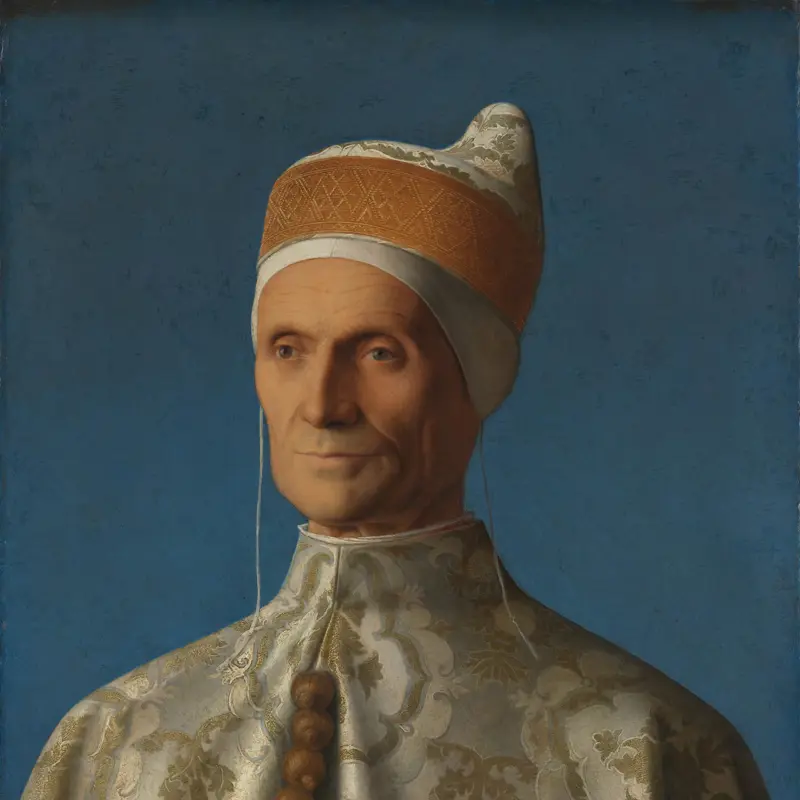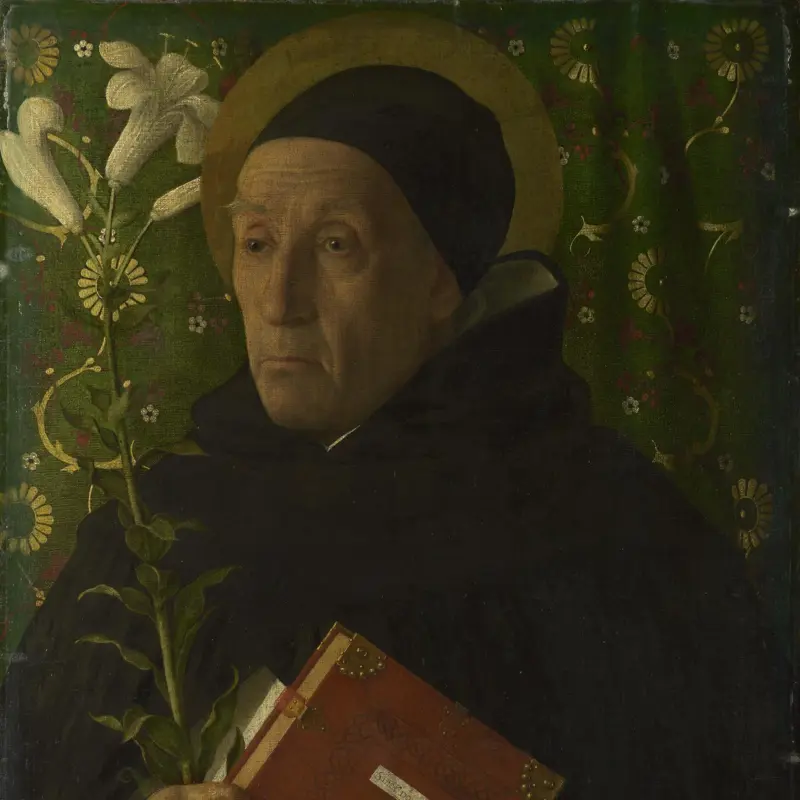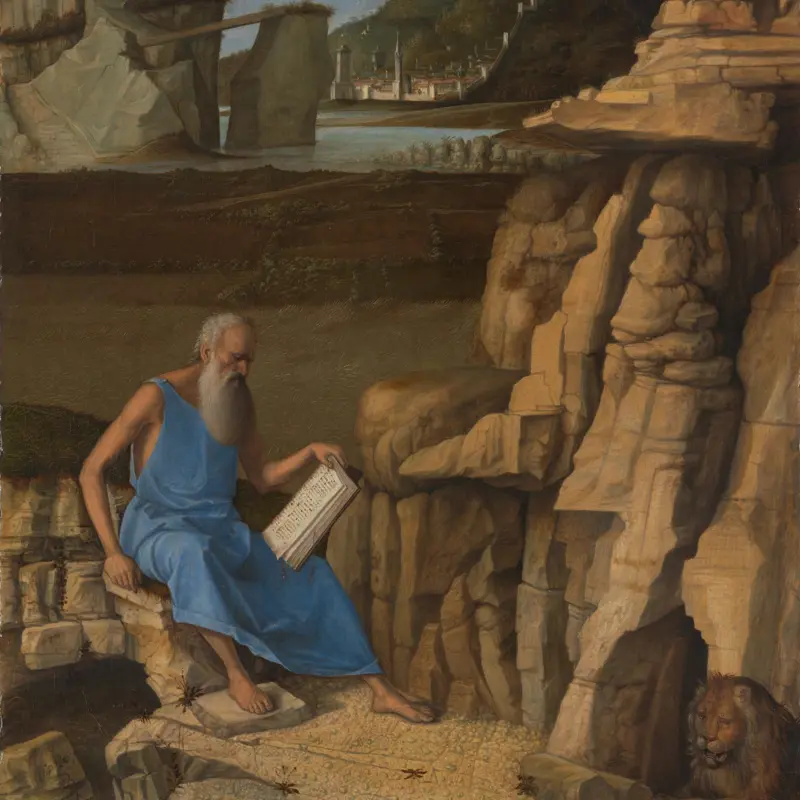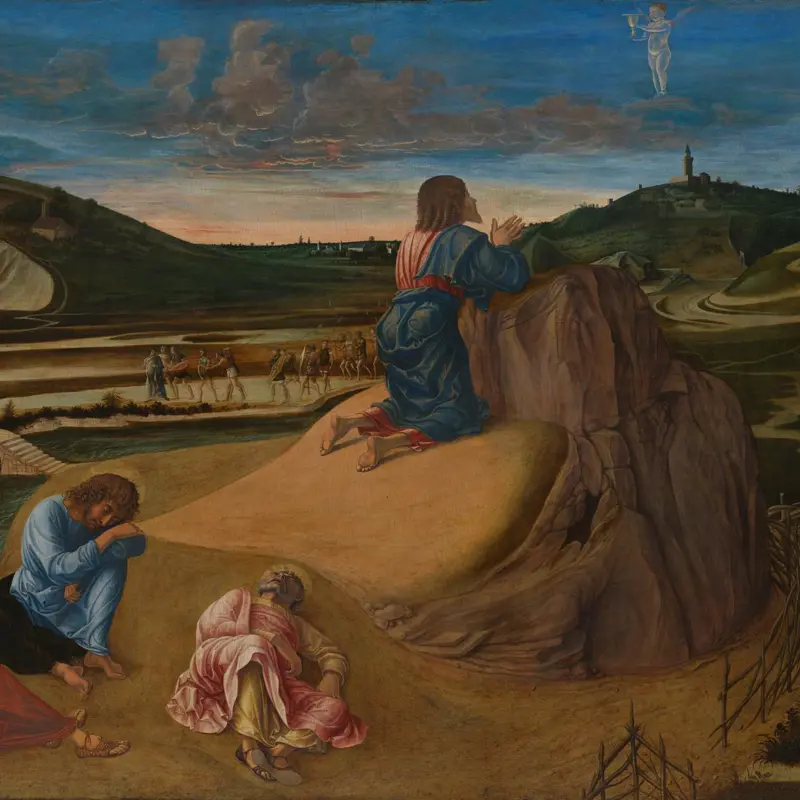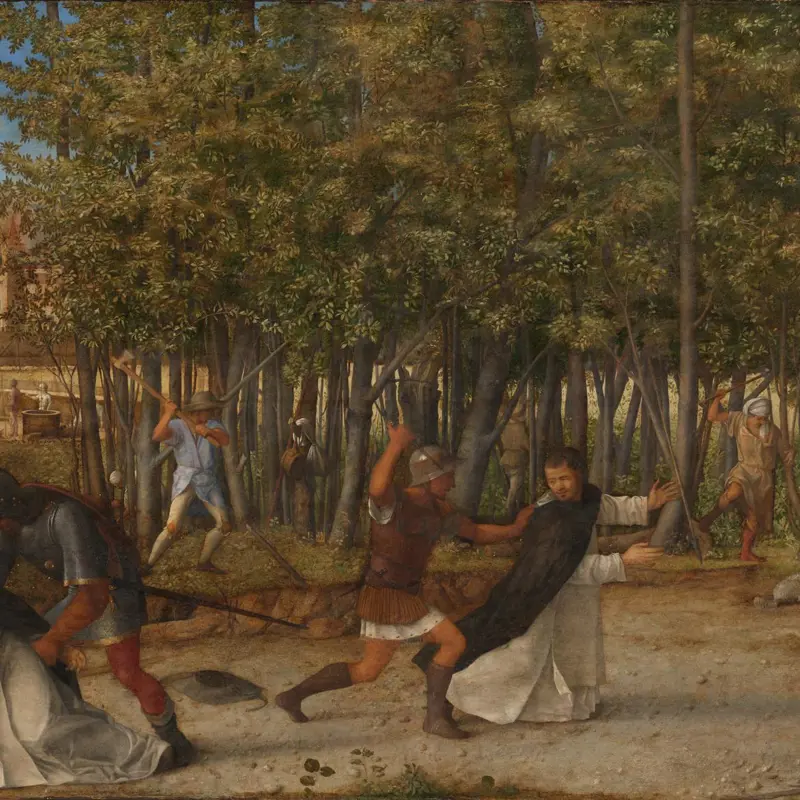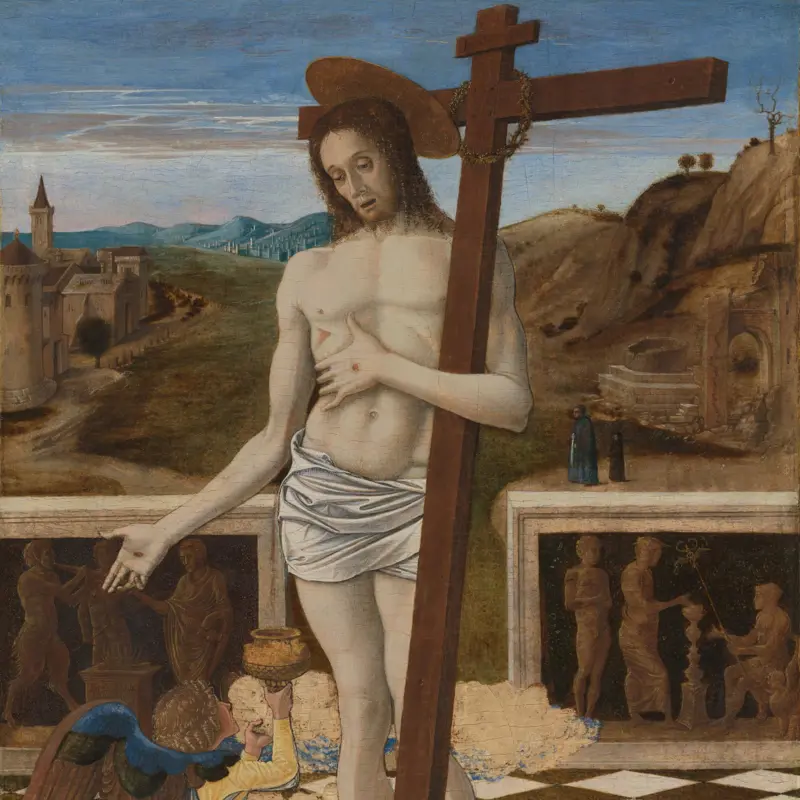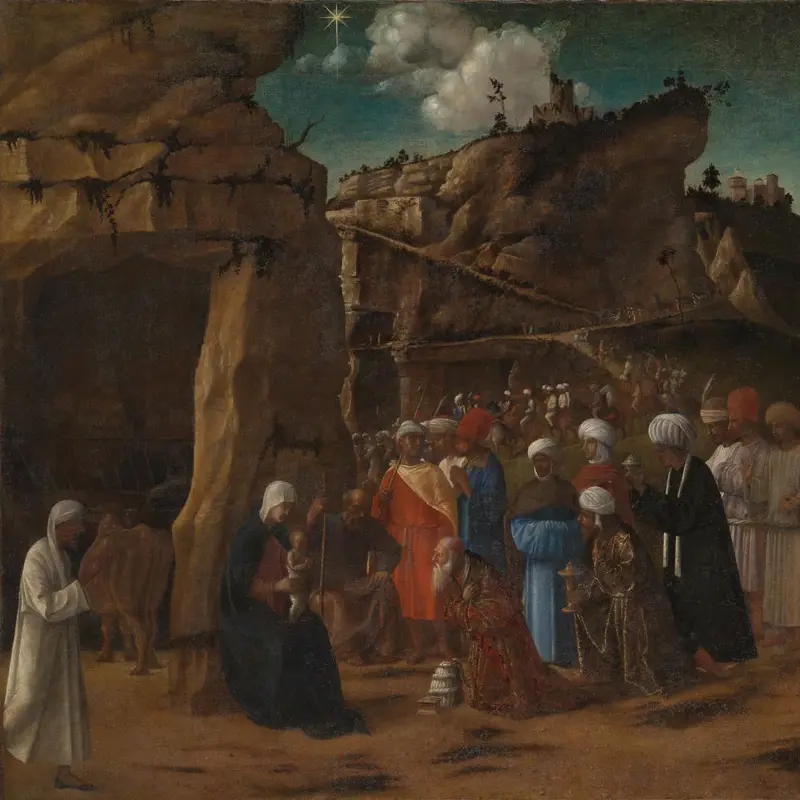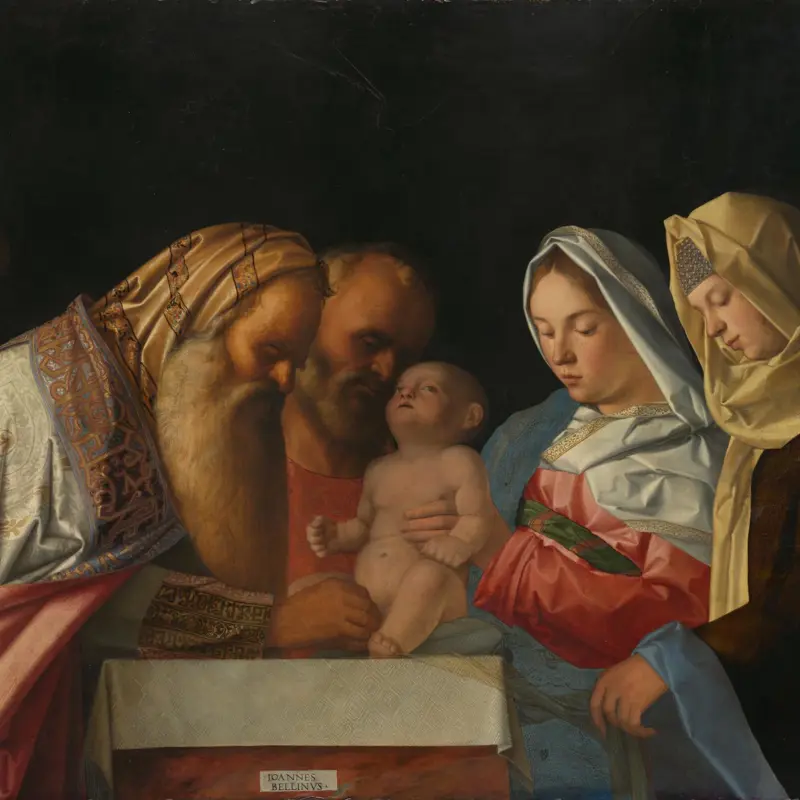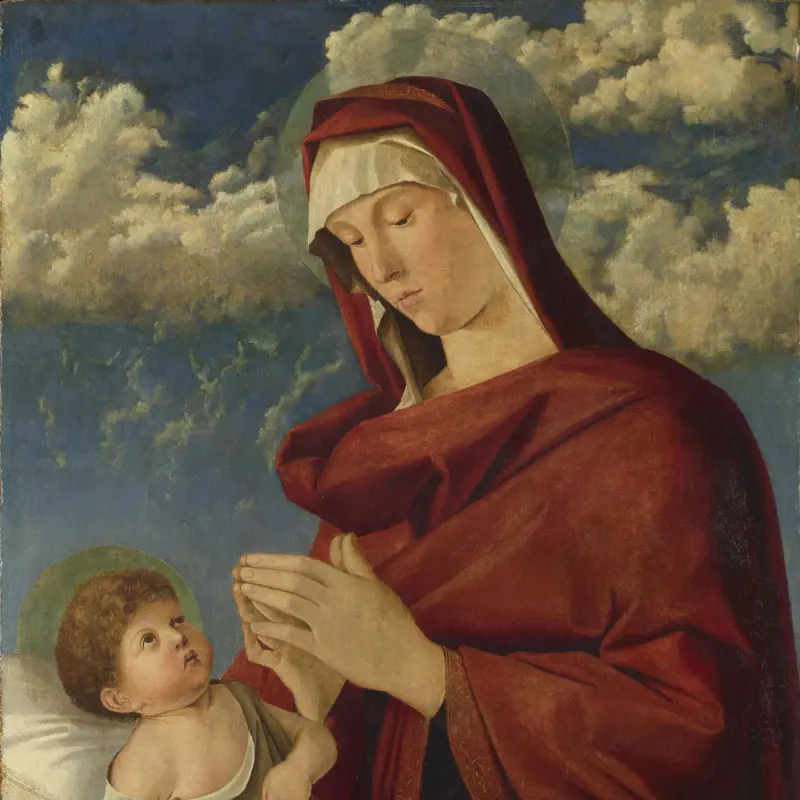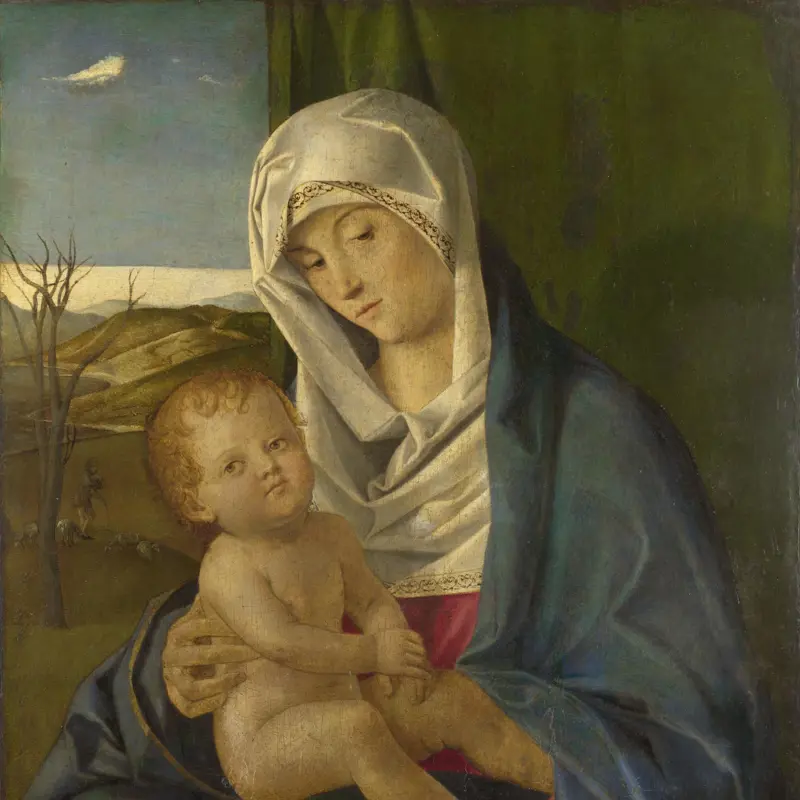Giovanni Bellini, 'The Virgin and Child', probably 1480-90
About the work
Overview
Small-scale images of the Virgin and Child made for private worship were a speciality of Bellini’s. This picture was thought to be by the artist’s assistants, but recent technical analysis showed that it was made by Bellini. The holy figures are separated from a landscape by a cloth of honour, and from us by a marble parapet; while they seem to be present in our space, their divinity places them just out of reach. Their tender gestures remind us of the humanity they share with us.
The pomegranate was probably added after Bellini had started painting, likely at the request of the patron. High-quality ultramarine – an expensive pigment made from lapis lazuli, a semi-precious stone – was used for the Virgin’s blue mantle.
This is the largest of Bellini’s pictures of the Virgin and Child which were not part of a larger altarpiece structure, suggesting that it was probably made to sit upon a small altar. Perhaps the owner had a private chapel in his home.
Key facts
Details
- Full title
- The Virgin and Child
- Artist
- Giovanni Bellini
- Artist dates
- about 1435 - 1516
- Date made
- probably 1480-90
- Medium and support
- oil on wood
- Dimensions
- 90.8 × 64.8 cm
- Inscription summary
- Signed
- Acquisition credit
- Bought, 1855
- Inventory number
- NG280
- Location
- Room 59
- Collection
- Main Collection
- Frame
- 16th-century Italian Frame
Provenance
Additional information
Text extracted from the ‘Provenance’ section of the catalogue entry in Martin Davies, ‘National Gallery Catalogues: The Earlier Italian Schools’, London 1986; for further information, see the full catalogue entry.
Exhibition history
-
2023Masterpieces from the National GalleryShanghai Art Museum East17 January 2023 - 7 May 2023National Museum of Korea2 June 2023 - 9 October 2023Hong Kong Palace Museum22 November 2023 - 11 April 2024Chimei Museum2 May 2024 - 1 September 2024
Bibliography
-
1844G. Lecomte, Venezia, Venice 1844
-
1847G. Fontana, Manuale ad uso del forestiere in Venezia, Venice 1847
-
1850G. Fontana, Venezia monumentale pittoresca, Venice 1850
-
1856R.N. Wornum, Descriptive and Historical Catalogue of the Pictures in the National Gallery With Biographical Notes of the Painters, 16th edn, London 1856
-
1856London, National Gallery Archive, dossier for NG 280: Report of the Director of the National Gallery to the Lords Commissioners of Her Majesty's Treasury, 5 March 1856
-
1857G.F. Waagen, Treasures of Art in Great Britain: Being and Account of the Chief Collections of Paintings, Drawings, Sculptures, Illuminated Mss. […], translated from German by Elizabeth Eastlake, 3 vols, London 1857, vol. 3
-
1867A.A. Lavice, Revue des musées d'Angleterre, Paris 1867
-
1871J.A. Crowe and G.B. Cavalcaselle, A History of Painting in North Italy: Venice, Padua, Vicenza, Verona, Ferrara, Milan, Friuli, Brescia, from the Fourteenth to the Sixteenth Century, 2 vols, London 1871
-
1878H. Blackburn, Illustrated Catalogue to the National Gallery: Foreign Schools, London 1878
-
1887M.-F. Reiset, Une visite à la Galerie nationale de Londres, 2nd revised edn, Rapilly 1887
-
1888E.T. Cook, A Popular Handbook to the National Gallery Including, by Special Permission, Notes Collected from the Works of Mr. Ruskin, London 1888
-
1891G. Frizzoni, 'L'arte italiana nella Galleria Nazionale di Londra', in G. Frizzoni, Arte Italiana del Rinascimento, Milan 1891
-
1898J.P. Richter, Lectures on the National Gallery, London 1898
-
1900R. Fry, Giovanni Bellini, 2nd edn, London 1900
-
1901A. Venturi, Storia dell'arte italiana, 11 vols, Milan 1901
-
1912D. Hadeln, 'Zwei Madonnenkompositionen des Giovanni Bellini', Zeitschrift für bildende Kunst, 1912, pp. 289-92
-
1916B. Berenson, Venetian Painting in America, New York 1916
-
1930G. Gronau, Giovanni Bellini, Stuttgart 1930
-
1932'The Friedsam Collection', Bulletin of the Museum of Modern Art, 61, 1932, pp. 37-8
-
1947P. Hendy, An Exhibition of Cleaned Pictures of 1947: (1936-1947), London 1947
-
1951Davies, Martin, National Gallery Catalogues: The Earlier Italian Schools, London 1951
-
1961M. Davies, The Earlier Italian Schools, 2nd edn, London 1961
-
1962F. Heinemann, Giovanni Bellini e i Belliniani, 3 vols, Venice 1962
-
1968G. Robertson, Giovanni Bellini, Oxford 1968
-
1978D. Robertson, Sir Charles Eastlake and the Victorian Art World, Princeton 1978
-
1985C.T. Dowd, 'The Travel Diary of Otto Mündler', The Walpole Society, LI, 1985
-
1986Davies, Martin, National Gallery Catalogues: The Earlier Italian Schools, revised edn, London 1986
-
1991J. Dunkerton et al., Giotto to Dürer: Early Renaissance Painting in the National Gallery, New Haven 1991
-
1992A. Tempestini, Giovanni Bellini. Catalogo completo dei dipinti, Florence 1992
-
1994P. Humfrey, 'Cima da Conegliano: Un decennio di ricerche e un convegno di studi', in Atti del Convegno Internazionale di studi su Giovan Battista Cima da Conegliano, Venice 1994, vol. 1, pp. 5-18
-
1995P. Humfrey, Painting in Renaissance Venice, New Haven 1995
-
2001
C. Baker and T. Henry, The National Gallery: Complete Illustrated Catalogue, London 2001
-
2018J. Dunkerton and M. Spring, 'Giovanni Bellini's Painting Technique', National Gallery Technical Bulletin, XXXIX, 2018, pp. 60-7
About this record
If you know more about this work or have spotted an error, please contact us. Please note that exhibition histories are listed from 2009 onwards. Bibliographies may not be complete; more comprehensive information is available in the National Gallery Library.

